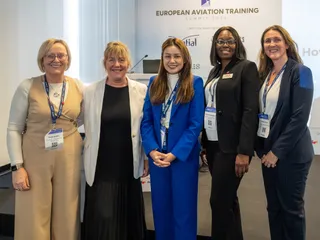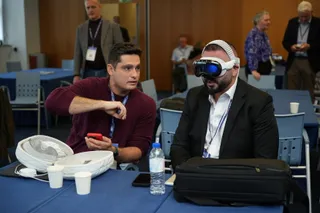EATS 2025 Proves VR Is Aviation's Training Future
Contact Our Team
For more information about how Halldale can add value to your marketing and promotional campaigns or to discuss event exhibitor and sponsorship opportunities, contact our team to find out more
The Americas -
holly.foster@halldale.com
Rest of World -
jeremy@halldale.com

The European Aviation Training Summit (EATS) concluded its second day in Cascais with a clear message: virtual reality has arrived as a proven training solution. Here's what you missed from the final day of presentations.
Virtual Reality Delivers Measurable Results
Day 2 showcased VR as more than emerging technology—it's delivering real performance improvements. AirTanker's Kerry Mitchell and Stephen Dargan presented their blended learning approach combining 360° tablet-based learning with VR cabin walkarounds, reporting increased confidence and better knowledge retention. The airline is pursuing UK CAA approval for VR as a valid alternative to live aircraft visits.
Bo Bennekov of AirVR introduced haptic technology using torque-controlled robotics running at 1,000 Hz to simulate realistic aircraft door resistance, addressing EASA training requirements while automatically logging performance data.
American Airlines shared results from seven years of VR integration, with Ali Preissinger's team presenting evidence of substantial trainee performance improvements immediately following VR sessions. Timothy Moser from Varjo Technologies supported this with US Air Force data showing pilot improvements in all 40 evaluated maneuvers, with 33 statistically significant. Dr. Toni Vallès-Català from CESDA confirmed that VR-trained students performed significantly better in practical flight tasks during their first real flight.
Competency-Based Training Expands Beyond Airlines
Nick Munns from Boeing challenged the relevance of traditional EASA Area 100 KSA group exercises in preparing pilots for real airline operations. His research across over 200 trainees suggests airline-centric, scenario-based training shows promise for ab initio through command training.
The EASA TRAIN Research Project presented new work applying competency-based assessment to PPL and CPL training at scale. Jenny Eaglestone and Dr. Christian Norden shared their experiment testing whether increasing FSTD hours by five while reducing aircraft training maintains effectiveness.
Addressing Training's Uncomfortable Truths
Helen Heenan from the UK CAA posed questions about cabin crew CRM training effectiveness, highlighting that regulations require no assessment whatsoever for CRM. She proposed ways to transform CRM from compliance checkbox to purposeful training.
Victor Potesta of Columbia Institute warned that inconsistent trainer standards create dangerous knowledge gaps directly impacting flight safety, emphasizing standardization and calibration as critical to CBTA success.
AI Implementation With Privacy and Purpose
Brussels Airlines demonstrated responsible AI integration by developing secure pipelines that constrain AI models to validated internal safety protocols. Working with Drillster, they embedded didactic AI into neuroscience-based learning approaches that measurably enhance retention.
Ryanair's Marcin Berezowski shared their evolution from paper handouts to AI-driven avatars narrating CRM case studies, while Lufthansa's Raghoonundun Gunputh advocated for performance-based, data-driven models enabling proactive hazard identification during training.
Maintenance and Cross-Generational Challenges
Brock Booher from Hilo Aviation reframed safety fundamentals, arguing that maintenance professionals don't "do" safety—they produce it through effective risk management. His metaphor of teaching teenage drivers illustrated why "be safe" messages fail without teaching hazard recognition and decision-making skills.
Booher also addressed modern cockpits' unprecedented challenge: four distinct generations working together. He proposed bidirectional mentorship where technology fluency meets operational wisdom, transforming potential conflicts into operational strengths.
Evidence-Based Training Matures
Michael Varney and Paul Field from Salient shared findings from reviews with 15% of their 80+ EBT operator customers worldwide, revealing that many instructors lack confidence coaching non-technical competencies. Matthias Spohr and Captain Frank Rindt from Lufthansa Aviation Training shared lessons from their A220 CBTA pilot project, addressing tensions between regulatory alignment and operational realities.
As EATS 2025 concludes, the insights shared in Cascais signal a pivotal moment for aviation training—one where technology amplifies human expertise, data drives smarter decisions, and evidence-based approaches redefine what it means to prepare the next generation of aviation professionals.


